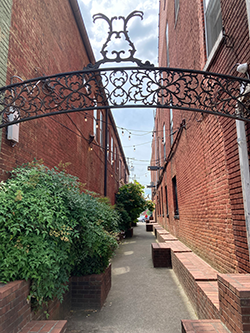Downtown: Part 3 – Activating Alleys
City alleyways often get a bad reputation as dark and spooky places. That’s changing. In fact, alleyways are a big deal in downtown development.

“Activated alleys” has been a featured topic in the national Main Street program in recent years. What is an activated alley? It’s a public alley space that allows people to feel welcome, safe, and comfortable. Several Kentucky cities have created new gathering spaces and “selfie spots” by simply cleaning, painting, and lighting alleys. Some also have tables and chairs, benches, planters, and murals.
Pikeville’s umbrella alley is a beautiful example.
According to Main Street Director Minta Trimble, the alley was an idea she had seen work in other cities and was a great way to brighten up an area between two buildings. Pikeville installed the umbrellas in July 2020, took them down in early November for the winter and reinstalled early in 2021. This spring and summer, the alley has also been the backdrop for paintings and photography displays by local artists.
“It’s really become a photo destination,” said Trimble, noting that there was recently a photo shoot with a Lamborghini in the umbrella alley.
Kitty Dougoud is the State Main Street Coordinator/Historic Preservation Program Manager at the Kentucky Heritage Council. She said the idea for alleys or other small spaces like pocket parks is to take unused space and make it useable – and enjoyable.
“Quality of life investments don’t have to be big projects or cost a lot of money.”
Your first step is to determine who owns the alley. If it belongs to the city, next consider your goals for the space. Will it be a gathering place, how will it contribute to the area’s overall architectural character, and will it enhance a business area during day or night hours? What about your pedestrian infrastructure? Are the pathways and building wall areas within the alley safe? Is it ADA accessible and compliant? Does it have adequate electricity for lighting, small music events, or food trucks? While these considerations are not necessarily difficult to address, codes, planning, police, maintenance, streets/public works, and your city attorney as well as your insurance carrier all need to be part of the conversation.
Planning and zoning considerations or approvals need to precede any type of work because alleys are part of a downtown’s transportation infrastructure, and some are still functional throughways or delivery routes. For those that are, simple things like murals, keeping the street clean, and lighting can add to the space. For alleys that are not used for vehicles, options are numerous.
As with other downtown beautification and development initiatives, stakeholders must be part of the activating alleyways process, and can make or break it. Businesses and restaurants, your tourism office, as well as nurseries and landscapers can all be partners in the process.
“You can have a city parking lot next to an intimidating ‘dark alley’… string some lights and you’ll have a much safer walk-through space,” said Dougood. “It’s good for businesses, too.”

The City of Cynthiana created an inviting alleyway in partnership with Main Street Cynthiana and the Chamber of Commerce. Maysville has an alley that includes outdoor dining. Campbellsville used a break between buildings as a space to landscape with flowerpots. Bardstown, Paducah and Georgetown are additional examples of cities that have turned alleyways into inviting pedestrian spaces.
When considering activating alleys, there are some things to keep in mind. The City of Spokane, Washington, created a guidebook and toolkit for what it calls “Innovation Alleyways.” The toolkit includes a number to technical and design considerations.
In downtowns, some alleys are private properties. In those cases, beautification and safety measures are a matter of working with the property owners, but many are eager and open to create safer, more highly trafficked areas because it increases their visibility and ultimately improves business.
The Pikeville Umbrella Alley is between two private buildings so Trimble worked with the owners for the project. She said one of the buildings is now leased by the city and its first floor is an incubator space for small businesses and artisans. The Shoppes at 225 is set to open in early September. It will house a plant shop, a home décor shop, a candy store and more as well as a creative space where the small business owners can hold classes and events.
Trimble said the larger goal for the building is to move the small businesses to their own brick and mortar spaces downtown Pikeville. They will be eligible to participate in Pikeville’s downtown incentive and rent subsidy programs.
“It all started with the alleyway,” said Trimble.
The City of Howell, Michigan, was recently named Main Street America’s Great American Main Street. In addition to its alleyways, the downtown has several pocket parks, which are another creative way to use downtown space.
Kentucky cities also have a number of unique examples of pocket parks including Paducah’s Art Park and some new spaces - Millstone Park in Richmond on a sliver of land between two buildings, Pineville’s renovated pocket park, and Salyersville’s brand-new downtown pocket park. Check out an article in Kentucky City magazine about some of Kentucky’s pocket parks.
Pocket parks and activated alleys take some planning and forethought. As with any type of downtown revitalization, collaboration is the key to success. They require a relatively small investment and can become a wonderful addition to your downtown. There are numerous grants available for landscaping, greenspaces and public art, and who knows, you may have a downtown business that would foot the bill for an entire alleyway rehab or park.
With planning, input, and safety as the priority, creative thinking can bring new life to invisible downtown areas. Activated alleys and pocket parks are small spaces that can bring big results.


